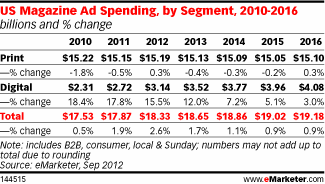News that Newsweek is exiting print was hardly surprising coming two years after the Washington Post Company unloaded it for a dollar.
But these numbers struck me while reading this Financial Times story on the news:
Newsweek has suffered more than some rivals. Its 1.5m circulation is less than half what it was five years ago, and Publishers Information Bureau data shows that its print advertising revenue plunged 70 per cent to $141m between 2007 and 2011, although the first half of 2012 showed a 13 per cent uptick.
Between 2007 and 2011, Time’s print advertising fell 20 per cent to $419m while The Economist, half owned by the FT Group, rose 20 per cent to $126m. Analysts at eMarketer expect US magazines’ print advertising revenues to increase marginally to $15.2bn this year.
It’s hard to lose 70 percent of your ad revenue in four years and make it. Twenty percent, as Time lost, is bad enough, but doable. But most interesting here is that last line that print mag ads are expected to rise this year, according to eMarketer. Say what?
If you’re like me, most of the impression you got from the Newsweek coverage was along the lines of print-is-dead/journalism-is-dying stuff. The Wall Street Journal, for instance, called the news “a signpost of how traditional print news outlets are being battered by an exodus of readers and advertisers to the Web.”
But as the Associated Press put it in a good counter-narrative, Newsweek is something of an outlier. It has been hit far harder even than other newsweeklies like Time, The Economist, and The Week.
It suffered an unhelpful stretch of editorial leadership. Newsweek in the previous regime suffered in part because multitask Jon Meacham “didn’t like the news and he didn’t like the week,” as Jack Shafer’s source memorably put it, and the magazine under Tina Brown was talked about more for trolling readers with cover stories than anything else.
EMarketer’s numbers are just forecasts, but there are a lot of magazines that aren’t doing too bad, which is saying something these days.
And it’s worth noting that eMarketer’s projection that print magazine revenue would increase this year was made in late September. The Association of Magazine Media numbers show that ad revenue was down 3.5 percent this year through September.
It’s also worth noting that eMarketer has had to significantly increase past projections of magazine revenue because they proved too pessimistic. Just a year and a half ago, the firm estimated that print magazine ads would total $13.2 billion in 2012. Now it says they’ll reach $15.2 billion (I’ve got some questions out to eMarketer about their numbers and will update when I hear back).
Even if you don’t buy that print magazine ads will flatten out through 2016 (and to be clear, it seems very unlikely to me), digital revenue is growing fast enough to offset most or all of any moderate print declines, according to eMarketer. Circulation revenues are declining, but at a manageable pace, particularly for subscriptions.
Ad Age‘s Simon Dumenco asks “Would You Rather Own a Magazine or a Digital Startup?” and makes a sharp point about the sustainability of print magazines as businesses compared to the average shiny new website:
The truth is, all ad-supported media — including magazines and digital-native companies — are operating in what continues to be a challenging environment. The difference with magazines is that they generally have to function as real companies with real revenues and real plans for how to survive and thrive. Unlike in Silicon Valley, there isn’t exactly a lot of venture-capital funny money floating around in the magazine world, propping up glossy pipe dreams and giving the illusion of success…
Meanwhile, over in the reality-based media community, a lot of magazines continue to be not only damn good businesses, but are doing better than ever.
It’s true that conglomerates or benefactors sometimes prop up magazines (see: Newsweek), but his point is still valid.
Two key questions for magazines are whether they can transfer subscribers over to tablets while continuing to get paid for and how much advertisers will pay on that format compared to print. Newsweek is trying to transition as many of its 1.5 million subscribers over to digital all at once, which almost certainly won’t work.
But it will be worth watching, particularly for publishers who aren’t yet forced to make the jump, just what Newsweek can salvage.
— Further reading:
Newsweek is dead … long live Newsweek? The end of its print run may not be all doom and gloom.
Ryan Chittum is a former Wall Street Journal reporter, and deputy editor of The Audit, CJR’s business section. If you see notable business journalism, give him a heads-up at rc2538@columbia.edu. Follow him on Twitter at @ryanchittum.

